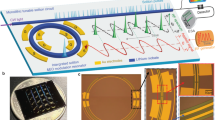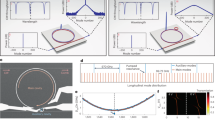Abstract
Microwave photonic technologies, which upshift the carrier into the optical domain, have facilitated the generation and processing of ultra-wideband electronic signals at vastly reduced fractional bandwidths. For microwave photonic applications such as radars, optical communications and low-noise microwave generation, optical frequency combs are useful building blocks. By virtue of soliton microcombs, frequency combs can now be built using CMOS-compatible photonic integrated circuits. Yet, currently developed integrated soliton microcombs all operate with repetition rates significantly beyond those that conventional electronics can detect, preventing their use in microwave photonics. Access to this regime is challenging due to the required ultra-low waveguide loss and large dimensions of the nanophotonic resonators. Here, we demonstrate soliton microcombs operating in two widely employed microwave bands, the X-band (~10 GHz, for radar) and the K-band (~20 GHz, for 5G). Driven by a low-noise fibre laser, these devices produce more than 300 frequency lines within the 3 dB bandwidth, and generate microwave signals featuring phase noise levels comparable to modern electronic microwave oscillators. Our results establish integrated microcombs as viable low-noise microwave generators. Furthermore, the low soliton repetition rates are critical for future dense wavelength-division multiplexing channel generation schemes and could significantly reduce the system complexity of soliton-based integrated frequency synthesizers and atomic clocks.
This is a preview of subscription content, access via your institution
Access options
Access Nature and 54 other Nature Portfolio journals
Get Nature+, our best-value online-access subscription
$29.99 / 30 days
cancel any time
Subscribe to this journal
Receive 12 print issues and online access
$209.00 per year
only $17.42 per issue
Buy this article
- Purchase on Springer Link
- Instant access to full article PDF
Prices may be subject to local taxes which are calculated during checkout





Similar content being viewed by others
Data availability
The data that support the plots within this paper and other findings of this study are available on Zenodo (https://doi.org/10.5281/zenodo.3666737). All other data used in this study are available from the corresponding author upon reasonable request.
Change history
18 May 2020
A Correction to this paper has been published: https://doi.org/10.1038/s41566-020-0649-2
References
Hecht, J. The bandwidth bottleneck that is throttling the Internet. Nature 536, 139–142 (2016).
Capmany, J. & Novak, D. Microwave photonics combines two worlds. Nat. Photon. 1, 319–330 (2007).
Supradeepa, V. et al. Comb-based radiofrequency photonic filters with rapid tunability and high selectivity. Nat. Photon. 6, 186–194 (2012).
Ghelfi, P. et al. A fully photonics-based coherent radar system. Nature 507, 341–345 (2014).
Khilo, A. et al. Photonic ADC: overcoming the bottleneck of electronic jitter. Opt. Express 20, 4454–4469 (2012).
Lim, C. et al. Fiber-wireless networks and subsystem technologies. J. Lightw. Technol. 28, 390–405 (2010).
Khan, M. H. et al. Ultrabroad-bandwidth arbitrary radiofrequency waveform generation with a silicon photonic chip-based spectral shaper. Nat. Photon. 4, 117–122 (2010).
Ataie, V., Esman, D., Kuo, B.-P., Alic, N. & Radic, S. Subnoise detection of a fast random event. Science 350, 1343–1346 (2015).
Temprana, E. et al. Overcoming Kerr-induced capacity limit in optical fiber transmission. Science 348, 1445–1448 (2015).
Riehle, F. Optical clock networks. Nat. Photon. 11, 25–31 (2017).
Rappaport, T. S., Murdock, J. N. & Gutierrez, F. State of the art in 60-GHz integrated circuits and systems for wireless communications. Proc. IEEE 99, 1390–1436 (2011).
Xie, X. et al. Photonic microwave signals with zeptosecond-level absolute timing noise. Nat. Photon. 11, 44–47 (2016).
Li, J., Yi, X., Lee, H., Diddams, S. A. & Vahala, K. J. Electro-optical frequency division and stable microwave synthesis. Science 345, 309–313 (2014).
Liang, W. et al. High spectral purity Kerr frequency comb radio frequency photonic oscillator. Nat. Commun. 6, 8957 (2015).
Marpaung, D., Yao, J. & Capmany, J. Integrated microwave photonics. Nat. Photon. 13, 80–90 (2019).
Kippenberg, T. J., Gaeta, A. L., Lipson, M. & Gorodetsky, M. L. Dissipative Kerr solitons in optical microresonators. Science 361, eaan8083 (2018).
Gaeta, A. L., Lipson, M. & Kippenberg, T. J. Photonic-chip-based frequency combs. Nat. Photon. 13, 158–169 (2019).
Torres-Company, V. & Weiner, A. M. Optical frequency comb technology for ultra-broadband radio-frequency photonics. Laser Photon. Rev. 8, 368–393 (2014).
Wu, J. et al. RF photonics: an optical microcombs’ perspective. IEEE J. Sel. Top. Quantum Electron. 24, 1–20 (2018).
Xu, X. et al. Broadband microwave frequency conversion based on an integrated optical micro-comb source. J. Lightw. Technol. 38, 332–338 (2019).
Moss, D. J., Morandotti, R., Gaeta, A. L. & Lipson, M. New CMOS-compatible platforms based on silicon nitride and Hydex for nonlinear optics. Nat. Photon. 7, 597–607 (2013).
Gyger, F. et al. Observation of stimulated Brillouin scattering in silicon nitride integrated waveguides. Phys. Rev. Lett. 124, 013902 (2020).
Herr, T. et al. Temporal solitons in optical microresonators. Nat. Photon. 8, 145–152 (2014).
Leo, F. et al. Temporal cavity solitons in one-dimensional Kerr media as bits in an all-optical buffer. Nat. Photon. 4, 471–476 (2010).
Stern, B., Ji, X., Okawachi, Y., Gaeta, A. L. & Lipson, M. Battery-operated integrated frequency comb generator. Nature 562, 401–405 (2018).
Raja, A. S. et al. Electrically pumped photonic integrated soliton microcomb. Nat. Commun. 10, 680 (2019).
Joshi, C. et al. Thermally controlled comb generation and soliton modelocking in microresonators. Opt. Lett. 41, 2565–2568 (2016).
Tian, H. et al. Hybrid integrated photonics using bulk acoustic resonators. Preprint at https://arxiv.org/abs/1907.10177 (2019).
Yang, K. Y. et al. Bridging ultrahigh-Q devices and photonic circuits. Nat. Photon. 12, 297–302 (2018).
Johnson, A. R. et al. Chip-based frequency combs with sub-100 GHz repetition rates. Opt. Lett. 37, 875–877 (2012).
Xuan, Y. et al. High-Q silicon nitride microresonators exhibiting low-power frequency comb initiation. Optica 3, 1171–1180 (2016).
Li, Q. et al. Stably accessing octave-spanning microresonator frequency combs in the soliton regime. Optica 4, 193–203 (2017).
Stone, J. R. et al. Thermal and nonlinear dissipative-soliton dynamics in Kerr-microresonator frequency combs. Phys. Rev. Lett. 121, 063902 (2018).
Pfeiffer, M. H. P. et al. Photonic Damascene process for integrated high-Q microresonator based nonlinear photonics. Optica 3, 20–25 (2016).
Liu, J. et al. Ultralow-power chip-based soliton microcombs for photonic integration. Optica 5, 1347–1353 (2018).
Guo, H. et al. Universal dynamics and deterministic switching of dissipative Kerr solitons in optical microresonators. Nat. Phys. 13, 94–102 (2016).
Morton, P. A. & Morton, M. J. High-power, ultra-low noise hybrid lasers for microwave photonics and optical sensing. J. Lightw. Technol. 36, 5048–5057 (2018).
Huang, D. et al. High-power sub-kHz linewidth lasers fully integrated on silicon. Optica 6, 745–752 (2019).
Mazur, M. et al. Enabling high spectral efficiency coherent superchannel transmission with soliton microcombs. Preprint at https://arxiv.org/abs/1812.11046 (2018).
Raja, A. S. et al. Chip-based soliton microcomb module using a hybrid semiconductor laser. Opt. Express 28, 2714–2721 (2020).
Nelson, C. W., Hati, A. & Howe, D. A. A collapse of the cross-spectral function in phase noise metrology. Rev. Sci. Instrum. 85, 024705 (2014).
Huang, G. et al. Thermorefractive noise in silicon-nitride microresonators. Phys. Rev. A 99, 061801 (2019).
Yi, X. et al. Single-mode dispersive waves and soliton microcomb dynamics. Nat. Commun. 8, 14869 (2017).
Weng, W. et al. Spectral purification of microwave signals with disciplined dissipative Kerr solitons. Phys. Rev. Lett. 122, 013902 (2019).
Spencer, D. T. et al. An optical-frequency synthesizer using integrated photonics. Nature 557, 81–85 (2018).
Newman, Z. L. et al. Architecture for the photonic integration of an optical atomic clock. Optica 6, 680–685 (2019).
Tang, J. et al. Integrated optoelectronic oscillator. Opt. Express 26, 12257–12265 (2018).
Merklein, M. et al. Widely tunable, low phase noise microwave source based on a photonic chip. Opt. Lett. 41, 4633–4636 (2016).
Do, P. T. et al. Wideband tunable microwave signal generation in a silicon-based optoelectronic oscillator. Preprint at https://arxiv.org/abs/1903.01137 (2019).
Li, J., Lee, H. & Vahala, K. J. Microwave synthesizer using an on-chip Brillouin oscillator. Nat. Commun. 4, 2097 (2013).
Gundavarapu, S. et al. Sub-hertz fundamental linewidth photonic integrated Brillouin laser. Nat. Photon. 13, 60–67 (2019).
Rice, P. et al. A 10 GHz dielectric resonator oscillator using GaN technology. 2004 IEEE MTT-S International Microwave Symposium Digest 3, 1497–1500 (2004).
Bauters, J. F. et al. Planar waveguides with less than 0.1 dB/m propagation loss fabricated with wafer bonding. Opt. Express 19, 24090–24101 (2011).
Spencer, D. T., Bauters, J. F., Heck, M. J. R. & Bowers, J. E. Integrated waveguide coupled Si3N4 resonators in the ultrahigh-Q regime. Optica 1, 153–157 (2014).
Karpov, M. et al. Raman self-frequency shift of dissipative Kerr solitons in an optical microresonator. Phys. Rev. Lett. 116, 103902 (2016).
Yi, X., Yang, Q.-F., Yang, K. Y. & Vahala, K. Theory and measurement of the soliton self-frequency shift and efficiency in optical microcavities. Opt. Lett. 41, 3419–3422 (2016).
Pfeiffer, M. H. P., Liu, J., Geiselmann, M. & Kippenberg, T. J. Coupling ideality of integrated planar high-Q microresonators. Phys. Rev. Appl. 7, 024026 (2017).
Liu, J. et al. Double inverse nanotapers for efficient light coupling to integrated photonic devices. Opt. Lett. 43, 3200–3203 (2018).
Acknowledgements
We thank N. J. Engelsen, G. Huang, W. Weng, M. A. Anderson and S. A. Bhave for discussions. This work was supported by contract no. FA9550-19-C-7001 (KECOMO) from the Defense Advanced Research Projects Agency (DARPA), Microsystems Technology Office (MTO), by the Air Force Office of Scientific Research, Air Force Materiel Command, USAF under award no. FA9550-15-1-0250, and by the Swiss National Science Foundation under grant no. 176563 (BRIDGE) and no. 165933. E.L. and M.K. acknowledge support from the European Space Technology Centre under ESA contract nos. 4000116145/16/NL/MH/GM and 4000118777/16/NL/GM, respectively. J.H. acknowledges support provided by H.-Y. Tam and the General Research Fund of the Hong Kong Government under project PolyU 152207/15E. H.G. acknowledges support from the European Union’s Horizon 2020 research and innovation programme under Marie Sklodowska-Curie IF grant no. 709249. The Si3N4 microresonator samples were fabricated in the EPFL Center of MicroNanoTechnology (CMi).
Author information
Authors and Affiliations
Contributions
J.L. designed and fabricated the Si3N4 samples, with assistance from R.N.W. and H.G. Samples were characterized and analysed by J.L. and J.H. J.H., J.L., A.S.R. and M.K. performed the soliton generation experiment. E.L., A.S.R., J.R., J.L. and R.B. performed the phase noise measurements and the soliton injection-locking experiment. J.L., R.B., E.L. and T.J.K. wrote the manuscript, with input from the other authors. T.J.K. supervised the project.
Corresponding author
Ethics declarations
Competing interests
The authors declare no competing interests.
Additional information
Publisher’s note Springer Nature remains neutral with regard to jurisdictional claims in published maps and institutional affiliations.
Supplementary information
Supplementary Information
Supplementary Information, including eight figures.
Rights and permissions
About this article
Cite this article
Liu, J., Lucas, E., Raja, A.S. et al. Photonic microwave generation in the X- and K-band using integrated soliton microcombs. Nat. Photonics 14, 486–491 (2020). https://doi.org/10.1038/s41566-020-0617-x
Received:
Accepted:
Published:
Issue Date:
DOI: https://doi.org/10.1038/s41566-020-0617-x
This article is cited by
-
Strong interactions between solitons and background light in Brillouin-Kerr microcombs
Nature Communications (2024)
-
Integrated optical frequency division for microwave and mmWave generation
Nature (2024)
-
All-optical frequency division on-chip using a single laser
Nature (2024)
-
Frequency-selective perovskite photodetector for anti-interference optical communications
Nature Communications (2024)
-
Breaking the efficiency limitations of dissipative Kerr solitons using nonlinear couplers
Science China Physics, Mechanics & Astronomy (2024)



